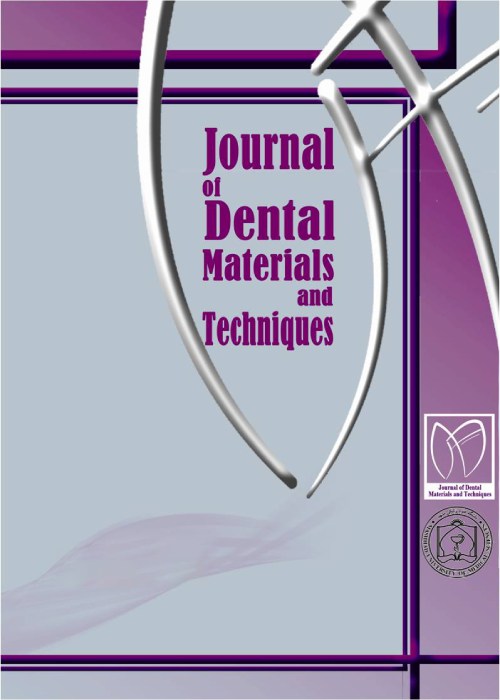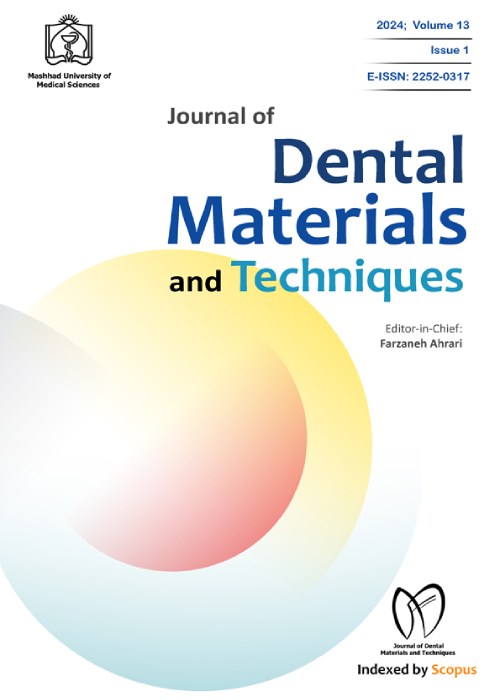فهرست مطالب

Journal of Dental Materials and Techniques
Volume:12 Issue: 3, Summer 2023
- تاریخ انتشار: 1402/06/10
- تعداد عناوین: 8
-
-
Pages 111-117Objective
This study aimed to assess the prevalence and morphology of the middle mesial (MM) canal in the mandibular first, second, and third molars of a Turkish population using cone beam computed tomography (CBCT).
MethodsIn this retrospective cross-sectional study, CBCT scans of 637 patients were analyzed. Molar teeth with complete root development and without prior root canal treatment were included, counting 2177 mandibular molars. The prevalence of isthmus and MM canal, and the morphology of the MM canals (confluent, independent, or fin-type canals) was determined in different molar groups. Data analysis was performed by the chi-square test, and the intra-observer reliability was assessed using the Kappa coefficient at a significance level of P<0.05.
ResultsThe overall prevalence of the isthmus and MM canal in mandibular molars was 51.36% and 8.36%, respectively. The prevalence of isthmus was greatest in second molars (54.78%) and the prevalence of MM canal was highest in first molars (15.58%). A significant association was found between the prevalence of isthmus and MM canal with the type of molar tooth (p<0.05), but the morphology of the MM canal was not significantly different among the molar groups (P=0.41). There was no significant relationship between the presence of the MM canal and the age and gender of the participants (P>0.05).
ConclusionsThe MM canal is occasionally observed in mandibular molars, predominantly in the first molars, emphasizing the need for accurate diagnosis to reduce post-operative complications. The majority of identified MM canals were of the confluent type.
Keywords: Cone-beam computed tomography, Dental pulp, endodontic treatment, molar, Mandible -
Pages 118-123ObjectiveAlthough oxidative mouthwashes have many antimicrobial benefits, it has been suggested that residual oxygen interferes with composite resin adhesion to dental structures. This study aimed to evaluate the effect of an oxidative mouthwash on the microleakage of composite restorations.MethodsTwenty-four extracted human third molars were randomly assigned into three groups: Group 1: a 0.05% sodium fluoride mouthwash, Group 2: an oxidative mouthwash, and Group 3: distilled water. The teeth were immersed in the corresponding solution for 10 minutes a day over 14 days. Class V cavities were prepared in the buccal and lingual surfaces of the teeth (n=15 per group) and restored with Filtek Z250 composite. The teeth were thermocycled between 5º C and 55º C for 1000 cycles, then immersed in 2% fuchsin solution for 24 hours, followed by sectioning in the bucco-lingual direction. The gingival and occlusal microleakage were inspected using a stereomicroscope. Data were analyzed using Kruskal-Wallis and Mann-Whitney U tests. The statistical significance level was considered at P 0.05.ResultsThe highest and lowest average microleakage scores were observed at the gingival and occlusal margin of cavities immersed in the sodium fluoride mouthwash, respectively. No statistical differences were observed in microleakage among the three groups either at the occlusal or at the gingival margin (P>0.05). The Mann-Whitney U test showed a statistically greater microleakage at the cervical (1.05±1.1) compared to the occlusal (0.694±0.53) margins, irrespective of the treatment groups (P=0.033).ConclusionsUsing an oxidative mouthwash does not affect the microleakage of composite restorationsKeywords: Composite resins, Dental restoration, Microleakage, Mouthwash, stereomicroscope
-
Pages 124-128ObjectiveThis study aimed to evaluate the effect of access cavity design on the amount of apically extruded debris in maxillary molars.MethodsTwenty-eight extracted maxillary molars were selected for this study. Inclusion criteria were caries-free teeth with mature roots and similar mesiobuccal root dimensions. The samples were randomly assigned into two groups, as follows: conservative endodontic cavity (CEC) and traditional endodontic cavity (TEC). Mesiobuccal canals of the teeth were instrumented using Reciproc instruments. Preweighed plastic tubes were used for collecting the apically extruded debris. The weights of plastic tubes (pre- and post-instrumentation) were determined using an electronic balance. The data were analyzed with an independent sample t-test, and a P-value < 0.05 was considered statistically significant.ResultsThe weight of apically extruded debris was significantly lower in the TEC group than in the CEC group (P =0.003).ConclusionsThe results of this in vitro study demonstrated that TEC preparation was superior to the CEC approach in terms of minimizing apical extrusion of debris.Keywords: Debris, Dental pulp, Dentin, Endodontics, molar, Root canal preparation
-
Pages 129-133Objective
This study aimed to evaluate the cyclic fatigue resistance (CFR) of three different heat-treated nickeltitanium (NiTi) files in rotary motion utilizing a cyclic fatigue testing device.
MethodsThree NiTi rotary systems, Hero Gold, NeoEndo Flex, and T-Pro were used in this study. Ten files from each system (4% taper, #25 size, 21mm length) were tested for CFR. The test was conducted in an artificial canal in a customized cyclic fatigue device. The canal system is comprised of a 60° angle of curvature located 8 mm from the orifice. All files were rotated until fracture at the rotation per minute (RPM) and torque settings according to the manufacturer's recommendation. The time to fracture (TTF) was recorded in seconds for each instrument and then multiplied by (RPM/60) to obtain the number of cycles to fracture (NCF). The fracture length of each instrument fragment was recorded. Data were analyzed by one-way ANOVA and Tukey test and P-value <0.05 was considered statistically significant.
ResultsThe NiTi rotary systems demonstrated significantly different TTF values (P=0.001). Hero Gold exhibited a significantly higher TTF (114.13±4.21), followed by NeoEndo Flex (65.24±2.20) and T-Pro (40.50±3.45). The difference in TTF was also significant between NeoEndo Flex and T-Pro groups (P<0.05). There was no statistically significant difference in the length of the fractured fragments between the three groups (P=0.08).
ConclusionThe Hero Gold file system demonstrated significantly superior CFR compared to the NeoEndo Flex and T-Pro systems, possibly due to differences in manufacturing processes for different file systems.
Keywords: Endodontics, Fatigue, file fracture, Root canal preparation, Root Canal Therapy, Rotary files -
Pages 134-141ObjectiveAttachments are used for connections between overdentures and dental implants. The maintenance of attachment components plays an important role in optimal clinical service of overdentures. This study aimed to compare the effects of overdenture insertion by hand pressure versus placement by clenching the jaws on the retention and diameter of resilient attachments.MethodsThirty patients with mandibular overdentures participated in this study. First, the patients were instructed to insert the overdentures with hand pressure. After 6 months, patients were recalled, the nylon matrix components of the attachments were replaced, and the patients were instructed to place the overdentures by clenching for the next 6 months. The retention and internal diameter of matrices were measured at baseline and at 6 and 12 months later. A universal testing machine was used to measure the residual retention, and a coordinate measuring machine was used to assess the matrix diameter. The retention loss and changes in matrix diameter were compared between the two techniques, using paired samples t-test.ResultsThe results showed that retention loss was lower in the hand placement method than in the clenching method (P<0.001). The two insertion methods were not significantly different regarding the amount of diameter increase (P=0.074).ConclusionsThe residual retention of the matrices was significantly greater in the hand placement of overdentures along the longitudinal attachment axis, which may result in greater efficacy and longevity of implant overdentures.Keywords: dental prosthesis, Implant-supported, Mandible, overdenture, Retention
-
Pages 142-148ObjectiveUnderstanding patients' perspectives is essential for treatment planning and assessing healthcare efficacy. This study explored the influential factors in root canal treatment (RCT) on patient satisfaction.MethodsThis prospective study involved 390 eligible patients who underwent RCT at the Department of Conservative Dentistry and Endodontics, B. P. Koirala Institute of Health Sciences, Dharan, Nepal. We collected data by assessing endodontic factors before treatment and using a post-treatment semantic differential scale questionnaire. Patients’ satisfaction was measured using a visual analogue scale (VAS) from 0 (least satisfaction) to 10 (highest satisfaction possible). Mann-Whitney U-test and Kruskal-Wallis test were employed for data analysis, and P-value<0.05 was considered statistically significant.ResultsPatients expressed high levels of satisfaction post-endodontic treatment (VAS 8.08). Patients were particularly satisfied with improved chewing ability (VAS 7.77), overall comfort (VAS 7.76), and aesthetics (VAS 7.63) after treatment. However, concerns were raised about treatment cost (VAS 5.97) and duration (VAS 5.86). Several factors were significantly associated with higher patient satisfaction levels including a diagnosis of pulpitis, younger age, lower DMFT (Decayed, Missing, Filled Teeth) score, fewer teeth requiring treatment, absence of flare-ups, teeth not used as an abutment for prosthesis, primary endodontic therapy, treatment of either molar or non-molar teeth (as opposed to both conditions), smaller periapical lesion size, and single-visit treatmentConclusionsOur findings reveal high overall general satisfaction, with chewing ability generating the highest contentment. Cost and treatment duration were areas of concern. Demographics, clinical variables, and treatment settings played roles in shaping perceptions. These findings offer insights for enhancing endodontic care and patient satisfaction outcomes.Keywords: Endodontics, Healthcare costs, Patient Satisfaction, Quality of life, Root Canal Therapy, Treatment outcome
-
Pages 149-154ObjectiveCone beam computed tomography (CBCT) is an imaging modality that has recently gained increasing popularity for dental imaging. This study aimed to investigate the usage of CBCT imaging among Iranian Association of Endodontists members using an online survey.MethodsIranian endodontic practitioners were recruited to participate in the study. A web-based questionnaire was designed and sent to 328 endodontists. The questionnaire was available for a one-month long period during November 2019. The questionnaire included basic demographic details of the participants and questions related to CBCT application in endodontic treatment procedures. The validity and reliability of the questionnaire were assessed by expert endodontists. The chi-square test was used for data analysis, and a p-value less than 0.05 was considered statistically significant.ResultsA total of 101 participants completed the survey, giving an overall completed response rate of 30.8%. Ninety-four percent of participants (n=95) used CBCT imaging in their practice. There were significant differences in some variables between endodontists who frequently prescribed CBCT as compared to those who rarely prescribed it (P<0.05). CBCT was prescribed more frequently by endodontists who received training in CBCT usage, those performing periapical surgeries, and those using magnification in their practice.ConclusionsThe survey indicated that CBCT technology is widely used among Iranian endodontists particularly if they have already received the required training. The most common indications for CBCT were detecting vertical root fracture, teeth with complex anatomy and additional canals, and root resorption.Keywords: Computer-assisted, Cone-beam computed tomography, Dental Imaging, Endodontics, Guideline, Radiographic image interpretation
-
Pages 155-159Objective
Management of a skin dimpling due to a chronic periapical lesion may pose challenges. This case report presents a multidisciplinary approach to resolving a persistent cutaneous scar of endodontic origin and also offers a flowchart for the management of similar cases.
Case report:
A 34-year-old female referred to the Endodontics Department of Mashhad Dental School at Mashhad University of Medical Sciences, complained of a skin dimpling on her face with a history of pus discharge. Diagnostic workup and radiographic examination revealed that the right mandibular first molar had a failing root canal treatment and a defective restoration. The respective tooth underwent endodontic retreatment. Due to palpation of a cord-like tract at the apical region of the tooth, surgical removal of the mentioned structure was planned using a mucoperiosteal flap. After flap elevation, the cord was cut at the base of attachment to the bone, which resulted in immediate correction of facial contour. Finally, the tooth was permanently restored. At the 6-month follow-up visit, the periapical lesion was healing, and the face had a normal contour.
ConclusionsConsidering the significance of surgical intervention in cases with a cord-like sinus tract and consequent skin dimpling, a flowchart for a step-by-step decision-making process is offered to better restore the normal facial contour.
Keywords: Cutaneous fistula, Differential diagnosis, Endodontic, Periapical Abscess, surgical treatment, Sinus tract


